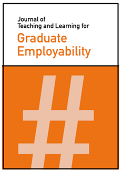Creating group work-integrated learning experiences for non-clinical health degrees: A practitioner reflection
DOI:
https://doi.org/10.21153/jtlge2024vol15no2art2028Keywords:
Work-integrated learning, WIL, employability, career readiness, career development, career skills, partnershipsAbstract
Work-Integrated Learning (WIL) experiences, integral for equipping students with the skills and knowledge crucial for employment and success in their chosen careers, have traditionally been associated with accreditation requirements in professional programs. More recently, acknowledging the importance of WIL experiences in non-professional programs has grown. In this reflective paper, the experiences of the practitioner tasked with developing a new WIL capstone course for students in Health and Biomedical Science degrees are described. Grounded in social exchange theory, where interactions are viewed as exchanges aimed at maximising rewards while minimising costs, the intent was for student groups to engage with a range of authentic project experiences offered by industry, community, and academic staff (the WIL partners). Critical elements were the active involvement of a diverse array of partners and the importance of relationship building for the long-term sustainability of the project experiences. I discuss and reflect on the specific strategies employed to engage the WIL partners, inspiring them to collaborate and develop meaningful projects suitable for students pursuing various career paths. Additionally, I reflect on the invaluable experiences and feedback provided by our partners.
Metrics
References
Australian Collaborative Education Network. (2020). How should we spend NPILF funds to improve Work Integrated Learning in generalist Science degrees? A joint discussion paper from Australian Council of Deans of Science (ACDS) and Australian Collaborative Education Network. https://www.acds.edu.au/wp-content/uploads/WIL-Partnerships-in-Science-ACENACDS-Joint-Statement-FINAL-1.pdf
Bourne, E., Short, K., McAllister, L., & Nagarajan, S. (2019). The quantitative impact of placements on allied health time use and productivity in healthcare facilities: A systematic review with meta-analysis. Focus On Health Professional Education: A Multi-Professional Journal, 20(2), 8–40. https://doi.org/10.11157/fohpe.v20i2.315
Bridgstock, R., Grant-Iramu, M., & McAlpine, A. (2019). Integrating career development learning into the curriculum: Collaboration with the careers service for employability. Journal of Teaching and Learning for Graduate Employability, 10(1), 56–72. https://doi.org/10.21153/jtlge2019vol10no1art785
Colson, N., Shuker, M. & Maddock, L. (2022). Switching on the creativity gene: A co-creation assessment initiative in a large first year genetics course. Assessment & Evaluation in Higher Education, 47(8), 1149-1166. https://doi.org/10.1080/02602938.2021.2011133
Cropanzano, R., & Mitchell, M. (2005). Social exchange theory: An interdisciplinary review. Journal of Management, 31(6), 874–900. https://doi.org/10.1177/0149206305279602
Department of Education, Skills and Employment (2021, February 2017). NPILF Pilot (2022-24) (Guidance Document). Australian Government. https://www.education.gov.au/download/11048/npilf-guidance-document/21153/document/pdf
Ferns, S. J., & Arsenault, C. (2023). Accreditation and quality in work-integrated learning: An international comparison. In K. E. Zegwaard & T. J. Pretti (Eds.), The Routledge International Handbook of Work-Integrated Learning. (3rd ed., pp. 113–130). Routledge. https://doi.org/10.4324/9781003156420-27
Hart, J. L., & Bone, E. (2022). Authenticity ahead of interdisciplinarity – a scoping review of student experiences in interdisciplinary science projects. Journal of Teaching and Learning for Graduate Employability, 13(1), 109–126.https://doi.org/10.21153/jtlge2022vol13no1art1487
Hobbs, D., & Vincent, T. (2023). Can a Full Semester of WIL Satisfy Students, Industry and the Accrediting Body Alike?. 1-9. Paper presented at 34th Australasian Association for Engineering Education (AAEE), Gold Coast, Queensland, Australia. https://tinyurl.com/5ea5z2sj
Hollweck, T., Netolicky, D.M. and Campbell, P. (2022). Defining and exploring pracademia: Identity, community, and engagement. Journal of Professional Capital and Community, 7(1), 6-25. https://doi.org/10.1108/JPCC-05-2021-0026
Jackson, D., & Dean, B.A. (2023). The contribution of different types of work-integrated learning to graduate employability. Higher Education Research & Development, 42(1), 93-110. https://doi.org/10.1080/07294360.2022.2048638
Jackson, D., Riebe, L., Meek, S., Ogilvie, M., Kuilboer, A., Murphy, L., Collins, N., Lynch, K., & Brock, M. (2023). Using an industry-aligned capabilities framework to effectively assess student performance in non-accredited work-integrated learning contexts. Teaching in Higher Education, 28(4), 802-821. https://doi.org/10.1080/13562517.2020.1863348
Kay, J., Ferns, S., Russell, L., Smith, J., & Winchester-Seeto, T. (2019). The emerging future: Innovative models of work-integrated learning. International Journal of Work-Integrated Learning, 20(4), 401-413. https://files.eric.ed.gov/fulltext/EJ1238315.pdf
Kemp, C., van Herwerden, L., Molloy, E., Kleve, S., Brimblecombe, J., Reidlinger, D., & Palermo, C. (2021). How do students offer value to organisations through work integrated learning? A qualitative study using social exchange theory. Advances in Health Sciences Education: Theory and Practice, 26, 1075–1093. https://doi.org/10.1007/s10459-021-10038-x
Linford, J., Trujillo, M., & Nogales, L. (2022). Improvement of project quality through team building. Proceeding of Capstone Design Conference, Dallas Texas. http://www.capstonedesigncommunity.org/sites/default/files/proceedings_papers/Linford_EtAl_TeamBuildingForProjectQuality_CDC22.pdf
Lloyd, S., Vasandani, M., & Salvacion, J. O. (2023). Graduate employment outcomes of health service management work integrated learning placements. Asia Pacific Journal of Health Management, 18(1), 98-108. https://doi.org/10.24083/apjhm.v18i1.1639
O’Dwyer, M., Filieri, R., & O’Malley, L. (2023). Establishing successful university–industry collaborations: Barriers and enablers deconstructed. The Journal of Technology Transfer, 48, 900-931. https://doi.org/10.1007/s10961-022-09932-2
Penman, M., Raymond, J., Kumar, A., Liang, R. Y., Sundar, K., & Thomas, Y. (2023). Allied health professions accreditation standards for work integrated learning: A document analysis. International Journal of Environmental Research and Public Health, 20(15), 6478. https://doi.org/10.3390/ijerph20156478
Downloads
Published
Issue
Section
License
Copyright (c) 2024 Natalie Colson , Louise Maddock, Mary-Ann Shuker, Sanger Georgina

This work is licensed under a Creative Commons Attribution-NonCommercial 4.0 International License.












